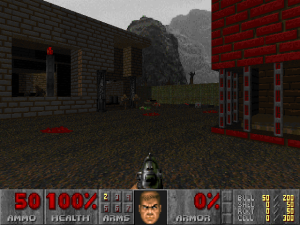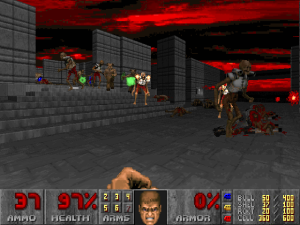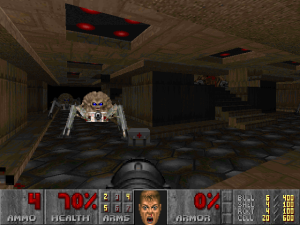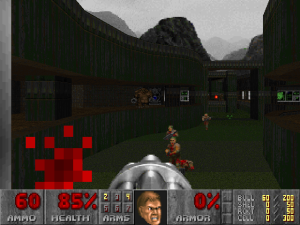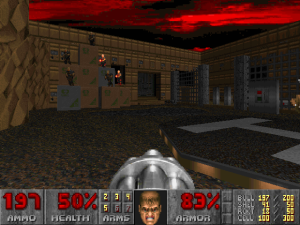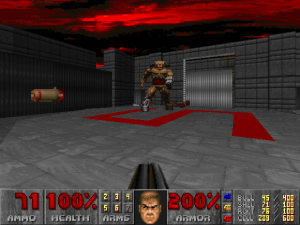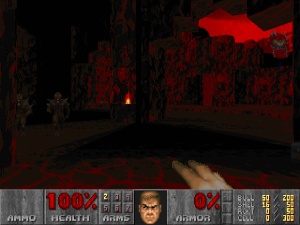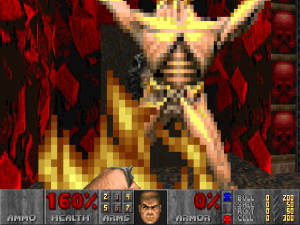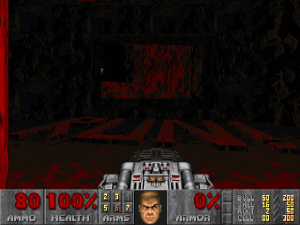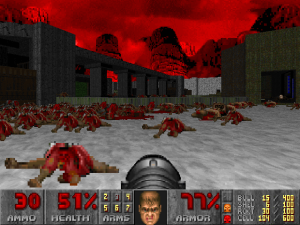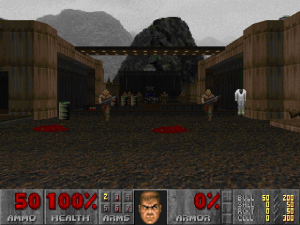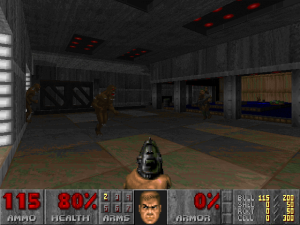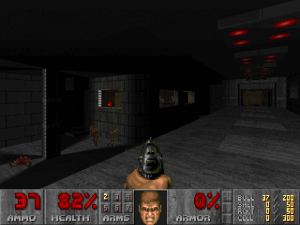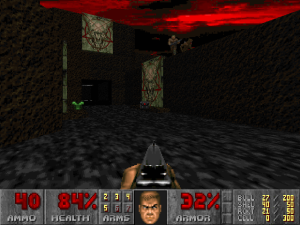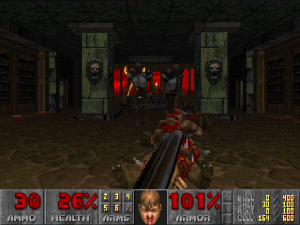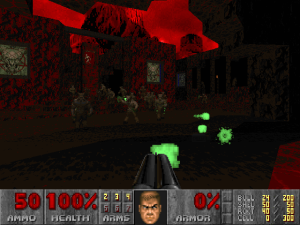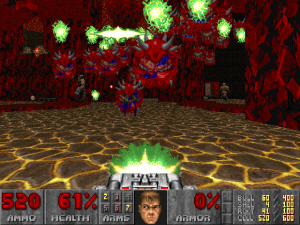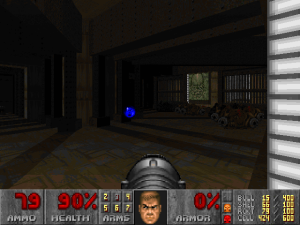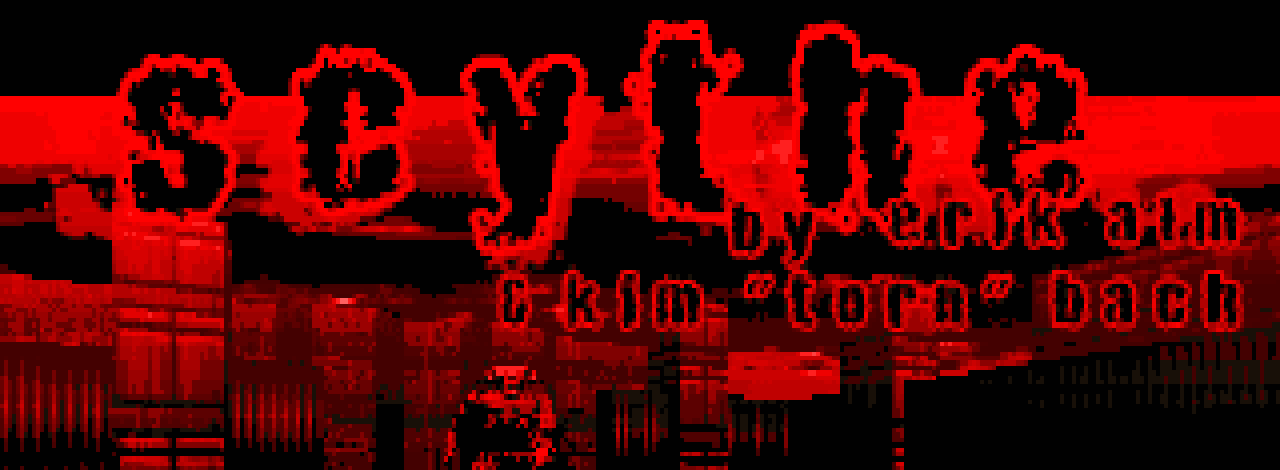
It’s weird to think that I’ve been doing this Doom thing consistently for over a decade. 2002 is when I really got into it, even if I did dabble in Doom as a kid back in ’94. I was a teenager by 2002: no longer terrified of the pixelated demons, and newly equipped to navigate the internet and find WADs to play. That’s where I found the three names that still embody that early time of wonder and discovery, as I first stepped into the glorious world of Doom WADs: STRAIN, 2002 A Doom Odyssey, and Scythe.
Returning to Scythe is like wrapping myself in a warm blanket and picking up a good book; it feels like going home. There’s no WAD quite so familiar, so easy to slip back into, so perfectly-crafted to pick up when you’re having a rough day and need to unwind.
It’s a strange phenomenon, but I find that the older I get, the less a full 32-map megaWAD appeals to me. So often they’re overlong, artificially stretched with tons of filler in order to reach that obligated 32 maps. They’d have been tighter at 25 or 18 or 6. Scythe is one of the exceptions — a master class in minimalistic level design, boiling off any trace of excess and leaving nothing but the essentials. This is the WAD that really made Erik Alm a household name in the Doom community, and deservedly-so. What’s even more incredible is that Scythe is essentially a speedmap WAD; Alm churned out all the maps (with one guest appearance by mapper Torn) in a period of less than two months, with all the work done across only 25 days.
But these aren’t just good when judged as speedmaps; these are some stellar maps by any measure. Sure, lots of mappers can churn out maps just as fast, but nobody does it at the level of quality that Erik Alm does. And if you can’t tell… yeah, I’m jealous.
Anyway, since there’s so much to say about Scythe, we’ll tackle it by episode. This WAD doesn’t take its episodic structure nearly as seriously as Scythe II, with its six wildly distinct chapters, but OG Scythe still carries you through a series of loosely-themed 10-map chunks, at the end of which you’ll die and be forced to begin the next from a pistol start — assuming you haven’t been playing that way all along, in which case it’ll just be business as usual.
Episode 1
Scythe’s first episode is its most traditional, if you can’t immediately tell by the Phobos sky graphic and abundance of E1 textures. Knee-Deep-inspired techbases? Check. Generic “nukage processing plants”? Yes, but not as dull as that sounds. A Dead Simple ripoff? It wouldn’t be a classic megaWAD without one!
You can’t get more vanilla than the flavors here in Scythe’s first act (and the next two episodes are maybe chocolate and strawberry at best). What the WAD lacks in original visuals, though, it makes up for in slick design and snappy combat. I don’t think you can craft levels shorter or sweeter than this. Rather than the base or compound or dungeon you’re likely to find as a level in any number of other megaWADs, each of this first episode’s maps is little more than a room or a courtyard. All the action takes place around — most often, within view of — a central area. Take the opener, for instance, “Get going!”, which encompasses two small brick buildings with wide-open windows facing each other across a tiny open space. Or Map03, with its central courtyard, around which you fight a 360 degree battle as a ring of corridors unfolds along the edges. Or “Garden base,” in the eighth slot, where you traverse the same area three times, first through a grassy channel, then once along the high ground on either side.
Each is one shockingly simple setpiece — but that’s where it draws the line. One area, one aesthetic, one gameplay gimmick to master. You always know exactly where you are and how that place relates to every other location in the map. And because they’re so short and laser-focused, every map can serve as its own independent, unique challenge instead of the series of battles, keyhunting, and more battles — the endurance test — that virtually all longer maps end up being.
I’d take a series of small, clever maps designed around a single concept over huge, sprawling slogs any day. You know… brevity is the soul of wit and all that. And given the brevity of the whole episode, before you know it, you’ve trashed the Lords of Map10 and we’re moving on to the next episode…
Episode 2
This is where things start to get off the ground. Scythe’s roots in the style of Doom IWADs are mostly out the window, except for one very obvious callback to The Inmost Dens in slot 15. Episode 2 is Scythe’s artsy phase — more conceptual and experimental. It begins with a berserk-fest, followed by a string of really great, moody offerings that make wonderful use of dark areas and creepy music.
A lot of the most iconic maps fall in this middle stretch, though maybe the most memorable to me has always been Map12, which when I played it genuinely made me afraid to leave the safety and light of its opening structure and walk in its eponymous, shadowy park. “Power outage,” Map14, ain’t bad either, featuring a really cool but criminally underutilized gimmick where the power and lights have to be turned on before the player can progress.
The stakes are raised in E2, but the level sizes aren’t. We’ve got arch-viles and revenants around every corner, and Alm is breaking out the plasma gun and rocket launcher to even the odds. But the centralized-area, courtyard-y design holds true for most of the episode. Map17 involves a little more time away from the central area than usual, with lots more conventional hallway battles and disconnected encounters. Not to mention big hordes of monsters for the first time in the mapset, a theme that’s carried with gusto into much of the third episode.
You also — for some reason — hop into a portal in Map18, which transports you to the year 3000 for the last two maps. I don’t know why exactly, but that whole stretch, beginning with the eerie docks of 18, through the shiny future city of 19, and culminating in a beautifully-scored showdown with the cyberdemon in 20… just my absolute favorite moments of Scythe.
Up next: Hell.
Episode 3
Where else for the final episode, right? Accept no substitutes; it’s got to be fire and brimstone.
Episode 3 of Scythe blew my mind when I first saw it. Here was some legit, classic, Biblical-ass Hell, the likes of which you’d never seen in Doom, Doom II, or even Final Doom. Six out of these ten maps are constructed almost entirely out of Doom‘s resident fire and brimstone texture, REDROCK. This is Hell, no question about it — carved straight out of molten rock, dripping with blood and lava, and populated by demons, demons, and more demons.
If the texturing and design wasn’t enough, Alm sells the dire nature of your predicament through each level’s music. The first four levels of Scythe’s Hell episode are some of the most perfectly-scored maps in Doom history; nothing could better send the message that you are in a very, very bad place. Well, except maybe the slightly unfair but extremely justified difficulty spike starting at Map21.
Episode 3 is a totally different animal. Fast reflexes and happy trigger finger was enough to get you through the last twenty-odd maps, even on Ultra-Violence. Now the game is all about keeping a cool head under pressure, planning ahead, and… knowing how to dance. These are heavily-choreographed fights straight out of Deus Vult, where firepower is far less important than some classic bob-and-weave skills. Ammo is tight, and you’ll be pitting plenty of hellspawn against each other and berserk-fisting the leftovers: demons, imps, even hell knights and arch-viles in some cases.
I’d really recommend starting each map from scratch; pistol-starts on this last stretch is 100% necessary to get the full experience of exhilaration and complete desperation. Just tread carefully and finish off all the monsters you’ve alerted if possible before investigating anything, because there are teleport traps and hidden monsters everywhere that will turn your carefully-laid plans to dust.
That’s 21 through 24, at least. At 25, Alm starts to vary things up again. Map25 and 27 are a bit slower and more understated, trading the molten rock for ash tunnels and brick libraries. There’s a thrilling (but surprisingly easy) slaughtermap at 26, and 28 is… unique, to say the least. It’s a race against the clock — run an obstacle course before a certain amount of time expires, or you do. A neat concept, but unfortunately totally impossible for me on UV.
So where’s that leave us? In the snow, oddly enough. Map29 introduces a snowy city aesthetic, which is carried into the final map as half of a fire and ice theme. But these levels aren’t just out of place visually — they feel like they’re out of a totally different megaWAD. It’s not so bad in 29, but 30 is the absolute antithesis to the rest of what Scythe stands for. I understand the need for an epic conclusion, but my completion time was nearly an hour for that one map — and that’s not counting probably about twenty deaths and reloads. (Seriously, it’s about ten times harder than any other map in the WAD.)
I can’t really decide whether I like the final map or not. It’s a good map, but is it a good Scythe map? If you don’t care that much whether the WAD is internally consistent, you’ll probably enjoy it just fine. But being the pedantic ass that I am, I don’t think I can. I have to wonder what Alm was thinking, because something like Map24, only a little grander, would have been the perfect note to end this thing on. After the actual final map, I just felt… tired.
Okay — we can’t end on that note. Scythe is too awesome to let a single map bring it down, even if it’s the very last one you’re likely to play. But there’s always IDCLEV to cheat your way to the super secret map, Enoz Soahc, which takes place in two tiny arena rooms, is concise and tightly-designed, and it’s fun. You know, like the rest of the WAD.
Scythe requires DOOM2.WAD and should run on any source port under the sun. If you’re not sure how to get it running, this may help. And for more awesome WADs, be sure to check these out!
